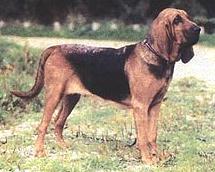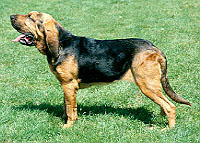Bloodhound


 Still known as the mighty Bloodhound in Britain and the United States, the breed is commonly referred to as the St.Hubert Hound in many countries, even though these two names had represented two entirely different breeds in the past. One theory suggests that the Bloodhound's name refers to the breed's pure lineage and noble breeding, contrary to the misconception that it is an insane blood-thirsty hunter. However, being able to follow a blood trail of man and beast alike was what made these dogs famous many centuries ago and the Bloodhound's name is much more likely used in honor of its working past rather than anything to do with romantic notions of supposed nobility. Massive, powerful and tall, the Bloodhound can be an intimidating watchdog, but in actuality this is a very friendly and calm breed. As a hunting dog, the Bloodhound is valued for its scenting ability and stamina, but the breed needs firm handling, due to its high working drive and stubborn nature. When not working, it appears sluggish and lazy, known to sometimes spend the entire day sleeping, earning the breed some comparisons to a cat. Sociable and even-tempered, the Bloodhound is a relaxed and devoted pet, loving of children and tolerant of other dogs. The breed is famous for its human-like facial expressions and wrinkled skin, as well as for its long hanging ears that are dragged on the ground when the dog is working the trail.
Still known as the mighty Bloodhound in Britain and the United States, the breed is commonly referred to as the St.Hubert Hound in many countries, even though these two names had represented two entirely different breeds in the past. One theory suggests that the Bloodhound's name refers to the breed's pure lineage and noble breeding, contrary to the misconception that it is an insane blood-thirsty hunter. However, being able to follow a blood trail of man and beast alike was what made these dogs famous many centuries ago and the Bloodhound's name is much more likely used in honor of its working past rather than anything to do with romantic notions of supposed nobility. Massive, powerful and tall, the Bloodhound can be an intimidating watchdog, but in actuality this is a very friendly and calm breed. As a hunting dog, the Bloodhound is valued for its scenting ability and stamina, but the breed needs firm handling, due to its high working drive and stubborn nature. When not working, it appears sluggish and lazy, known to sometimes spend the entire day sleeping, earning the breed some comparisons to a cat. Sociable and even-tempered, the Bloodhound is a relaxed and devoted pet, loving of children and tolerant of other dogs. The breed is famous for its human-like facial expressions and wrinkled skin, as well as for its long hanging ears that are dragged on the ground when the dog is working the trail.
The coat is short, flat and dense. Found in all colours in the past, the present-day incarnation of the breed comes in fawn, tan, red and brown shades, usually with a black "saddle" on the back. The average height is around 27 inches, but taller examples exist.
